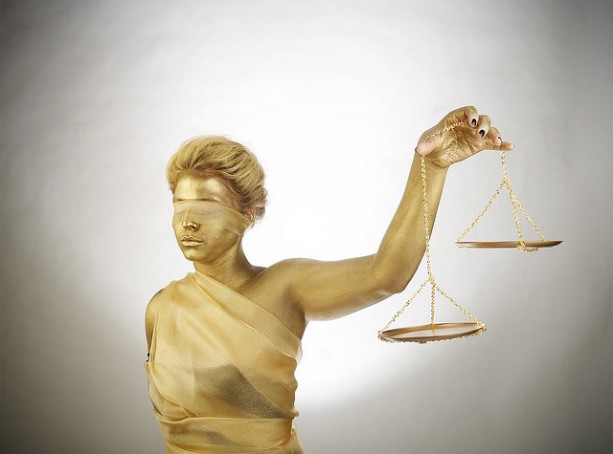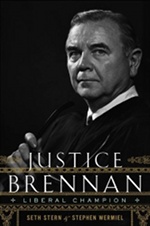
Justice Brennan: Liberal Champion
by Seth Stern and Stephen Wermiel
—Reviewed by Adam Fleisher

William Brennan was a relatively obscure judge on New Jersey’s highest court when President Eisenhower nominated the Democrat to the Supreme Court. The nomination was generally well received on both sides of the aisle. But Brennan had written some opinions that ‘might have given a conservative Republican pause,” in the foreboding words of Seth Stern and Stephen Wermeil. And indeed, from the moment Brennan arrived on the Court in 1956 until he retired in 1990, he proved to be quite the “liberal champion.”
The Supreme Court was already unpopular with many Americans when Brennan joined the bench, just two years after Brown v. Board of Education had declared segregation unconstitutional. Early decisions he wrote, including a holding in an antitrust case that Fortune magazine called “basically an anti-big business law,” only deepened the backlash. More controversial decisions would follow, as the Court barred prayer in schools, expanded the protections provided accused criminals, moved against the death penalty, expanded welfare rights, upheld affirmative action, and, most memorably, ruled on birth control and abortion. With comprehensive access to Brennan’s case histories, Stern and Wermeil shed light not only on the many significant and controversial opinions he wrote himself, but also on the integral role the “able tactician” played behind the scenes in cajoling and shaping the voting majorities for many watershed opinion. Shortly before Roe vs. Wade, for example, Brennan had defended the right to privacy for unmarried couples as it related to access to contraception, laying out a clear theoretical framework for Roe and helping the secure Justice William O. Douglas’ vote.
Brennan “clearly embraced an active role for the courts as an engine for social change,” a theme that defined both his career and Stern and Wermeil’s biography. In 1963, The Washington Post published concerns about the extent of the Court’s intervention into everyday life and its “trend of creativity” in getting there. Meanwhile, former justices worried about the Court’s lack of deference to established law and its emphasis on solving social problems that state legislatures were either unable or unwilling to address. But Brennan dismissed the notion that he was bound by precedent and narrow interpretations of the Constitution’s text. Rather, as he would tell his new clerks, the most important thing they needed to know was “five”: With a majority, the Court could do anything.
Brennan’s philosophy was a recipe for widespread social change, but whether it could prevail was another matter. He sought to bar the death penalty on the grounds that it was a cruel and unusual punishment that did “not comport with human dignity,” a concept the authors gently describe as “amorphous.” Critics would come to “single out his use of human dignity as his most egregious act of judicial activism,” a term that was invented to describe Brennan’s jurisprudence. At least three other justices, for instance, were personally hostile to the death penalty but believed that only the legislative branch had the power to do anything about it. Brennan’s critics argued the Justice was “laying out a moral vision rather than a legal standard,” a theory Stern and Wermeil seem to embrace.
Because Brennan saw constitutional law as a numbers game, he had reason to worry about whether the watershed decisions would endure as justices with different philosophies joined the Court. In spite of the rise of a conservative jurisprudence over the past 25 years, many of the significant decisions Brennan authored or influenced live on, especially those relating to the expansion of the Bill of Rights’ protections to the states and a more robust idea of equality under the Fourteenth Amendment. Part of that trend was due to “unexpected voting habits of his colleagues.” For instance, though the elevation of Justice Antonin Scalia was expected to make the Court significantly more conservative, he agreed with Brennan surprisingly often. In particular, Scalia voted with the liberals to provide the critical fifth vote to strike down a portion of a 1971 election law as a violation of the First Amendment. The irony, not indulged by Stern and Wermeil, is certainly not lost on readers in the wake of the 2010 Citizens United decision.
As for Brennan’s overall legacy, the fact that his activist approach is no longer in vogue has actually helped some of his more controversial decisions endure. The Court, after all, generally defers to precedent, and Brennan gave “judicial activism” such a bad name that any attempt to overturn past decisions is loudly condemned for being just that. Meanwhile, Brennan’s activism did play a role in the increased politicization of the Court: bitter fights like the one over Robert Bork’s nomination now seem inevitable, given that Constitutional law is defined by the magical five votes.
Today’s liberals may pine for another Brennan, but it isn’t in the cards. However, it’s equally unlikely there will ever be a conservative with as much long-term impact as Brennan. He may have lost the battle over whether judicial activism was a good idea, but he won the war with the social change he helped usher in.
Excerpt: Brennan sat at the far end of the justice’s conference table on April 2, 1976, and announced to his colleagues that he would never again vote to sustain a death sentence. “I’m absolutely convinced that it’s ‘cruel and unusual,’” he later recalled saying. “And that’s where I’m going to be from now on.” Brennan proved good to his word. From that point forward, he would issue a dissent in every case upholding a death sentence, noting his view that “the death penalty is in all circumstances cruel and unusual punishment prohibited by the Eighth and Fourteenth amendments.”
Buy the book: Skylight Books, Powell’s, Amazon
Further Reading: Louis D. Brandeis: A Life, by Melvin I. Urofsky; Supreme Power: Franklin Roosevelt vs. the Supreme Court by Jeff Shesol
Adam Fleisher is a law student at the University of Virginia.
*Photo courtesy of rememberthrough.




Send A Letter To the Editors